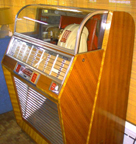
Juke Box Epilogue
Put another Nickel In!

Here are some helps to finding things on this page. This page provides a very brief look at the Jukebox after the "Golden Age." Sadly, the nature of public places changed in part because the prosperity of the 1950s gave people homes in which to entertain, so there was no need to go to the corner bar or malt shop to socialize. By process of elimination, public places attracted less and less respectable people. Many cities enacted ordinances requiring a specific (and expensive) license for dancing, sending the jukebox into a death spiral. This page provides a brief look at that period.
- Overview and Introduction
- Part 1: Jukebox Mechanics (Separate Page)
- Part 2:Julebox Aesthetics (Separate Page)
- Part 3: Juke Box Companies (Separate Page)
- Epilogue [This Page]
In case you didn't read any of the other pages here is some introductory material. BUT, If you want, you can go directly to the Epilogue
If you're reading this in 2011 (or later), the word "jukebox" means a gaudy prop in a retro diner or an image on a "Fabulous Fifties" party favor. In fact, if not for retro theme restaurants (like the Silver Diner), most of you would have never seen or heard of a jukebox. It is about a 50-1 bet that none of you have ever seen a real mechanical jukebox playing 78 rpm records, and it's about 1000-1 that any of you ever played a song for a nickel in a roadhouse. I'm writing this to integrate a lot of information that's out there on the internet. I'm going to package it for you so that you get a little history, a little mechanical engineering, some business strategy and a true aesthetic experience. We're also going to toss in some of the original patents so that you can see how things work.
First of all, they're not jukeboxes -- in their heyday, they were known as coin-operated phonographs. They were found in the best of establishments and were a multimillion dollar business. The cast of characters includes a wide variety of colorful individuals including brilliant designers, a millionaire right-wing Senator, gangsters, and even the KGB. This was cutting-edge technology that pushed electro-mechanics to its limits. It was the beginning of "hi-fi" and it was the pulse of the nation's taste in music -- the Radio and TV show Your Hit Parade informed listeners that the ratings were based on a survey of:
"the best sellers on sheet music and phonograph records, the songs most heard on the air and most played on the automatic coin machines, an accurate, authentic tabulation of America's taste in popular music."
Most people who danced during the period 1930-1950 did so to music provided by a jukebox. With the exception of the very, very elite places, most restaurants from Chez Pierre to Pete's Bar had a coin-operated phonograph to provide dance music to their customers. This was a LOT of places, and it is generally estimated that two million boxes were made. The folks who made coin operated phonographs (principally Wurlitzer, AMI and Seeburg) engaged in large scale nationwide advertising campaigns to convince poeople that the jukebox was a legitimate and "high-class" form of entertainment. Of these, Wurlitzer is the most remembered name, thanks to two factors: (1) a remarkable series of full-page ads drawn by Albert Dorne and (2)the Model 1015 Jukebox, both of which are shown below:
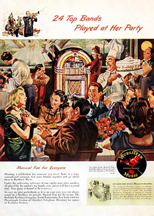
1947 Albert Dorne Ad Featuring the Wurlitzer Model 1015 Jukebox
Click to Enlarge
By examining this ad, we can learn a little about the times. First, you'll note that this scene takes place in a fairly classy restaurant -- the waiter (upper left) is wearing a mess jacket. There is a mural of a prince and princess on the wall, and the headwaiter (smiling at the kitchen door in black tie) is presiding over a birthday party for a lucky young lady. Not only that, a cliche chef in toque and pencil moustache has prepared a special (and large) birthday cake. There are a dozen roses on the table. All of the [clearly] non-ethnic patrons are having the time of their life. There is nothing at all about this scene that could be remotely considered as "low class." Here are some ads from the Seeburg company's internal paper. One shows a really classy Art Deco bar that had recently been "closed" to jukeboxes; the other shows a white-tie wedding with music by a jukebox. [this was only possible in the Seeburg magazine...]
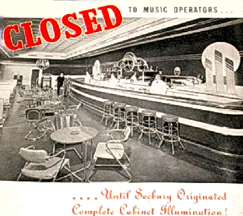
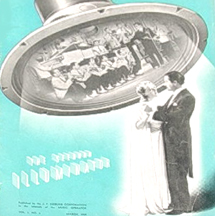
Seeburg Ads suggesting that the Juke was High Class
Click to Enlarge
As you might guess, there is a little sociology involved here. Manufacturers were continuously improving the technology and appearance of their products, sometimes with new variants issued on a monthly basis. The "very latest" machines with the most features and the best styling were designated "Top Boxes" and were destined for high end establishments. As the new moved in, the old was recycled down the status chain (of the time) until they reached rock bottom in the seedier roadhouses. In those bigoted times, when the machines reached into Negro neighborhoods, they acquired their enduring name, since "Juke" was slang at the time for "dancing". This is a lot less of a mouthful than "automatic coin operated phonograph," so like "Jitterbug", "Zoot" and "Rebop" the African-Americans had the last word. On a sad note, after the machine had been recycled down the chain, it was scavenged for parts and the rest destroyed. This is why boxes from the 1920s and 1930s are very rare.
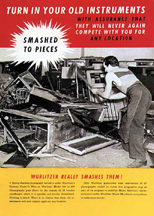
We Really Smash Them
Wurlitzer Trade Ad from the 1930s By a new jukebox! The old one won't compete with you...
In 1942-1945, the were sent overseas with the Armed Forces
Click to Enlarge
The Model 1015 had the largest production run of any single jukebox model. Wurlitzer estimates that more than 60,000 of the units were shipped. With bubbler tubes that changed colors, it was very entertaining -- so much so that owners preferred to keep this model instead of switching to newer boxes, even those with much improved technology. When the industry moved from 78 rpm to 45 rpm records, many of the 1015s were retrofitted and continued to serve in the 1950s. The natural downward evolution of the jukebox placed this machine in malt shops, drug stores and other places frequented by teenagers just at the time that Rock'n'Roll was emerging. The 1015 is, in fact, an icon of teen culture in the mid-1950s even though it was introduced in 1947 to play the music of their parents (see ad above.). It is the most often pictured jukebox and is immediately recognizable today. In fact, the remnants of the Wurlitzer company still makes them today -- they play CDs and some even use iPod technology to offer thousands of selections.
You have a some choices now:
- Read about Jukebox Mechanics Separate page
- Read about Jukebox Aesthetics Separate page
- Read about Companies that made Jukeboxes Separate page
- Read about The end of the Jukebox Era THIS Page
- Look at Some Other Kind of Swing Era Nonsense
The Golden Age of the jukebox was largely over by the start of the 1950s. The World War II generation largely stopped dancing except maybe at weddings. Jukeboxes were chrome monsters that were something like cable TV -- they had lots of theoretical selections, of which only a few were worth hearing. (The machines eventually offered 200 selections, but 100 of them were "B" sides.) Like toothpastes, mouthwash and margarines and other products spewed from corporate America, the "choice" was at the surface only.
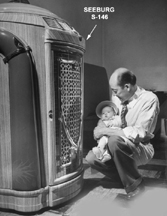
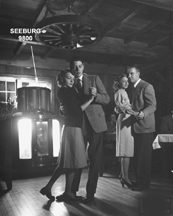
In 1946, the Jukebox Was for All Generations
(left) Seeburg model 146 "Trashcan" jukebox (right) Seeburg Model 9800 jukebox
Click to Enlarge
There was a time when people, both young and old, went to the drug store or ice cream parlor. In the 1940s, the jukebox played "popular" music in the sense of "music of the people" -- the kids might lean toward Gene Krupa while their elders leaned toward Wayne King, but all generations understood and enjoyed the music. Harry James and Artie Shaw recorded ballads with strings while Guy Lombardo and even Lawrence Welk had some real "Killer-Dillers." Since the jukebox only had 20 selections, the available music represented a compromise tilted toward those who were most free with their nickels. There were lots of syrupy ballads and nonsense tunes, but there were always one or two solid jump tunes for the dancers.

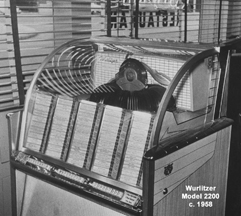
Exercising Choice in the Mid 1950s
Click to Enlarge
The mid 1950s changed all of that because there were 200 selections, allowing almost everyon to have what he or she wanted without compromise. Hence, teenagers voted overwhelmingly for Chuck Berry and Elvis Presley while Mom and Dad voted for Bing Crosby and Perry Como. The persistence of teenagers apparently won out, and certain places became known as "teen hangouts" thus resulting in physical as well as aesthetic separation of the generations. Invariably, the jukebox became associated with rock and roll, jive dancing and teenage courtship rituals. Mom and Dad began opting to stay at home and watch television.
The "Twilight of the Jukebox" might have been written by Richard Wagner, because it is said that before the gods destroy someone, they first drive him mad. The end of the juke era may have occurred sometime in the early 1960s where the coin operated phonograph passed from a viable item of commerce into the realm of nostalgia. As shown below, a jukebox collector was discovered by a photographer. Even though his collection is absolutely superb, displaying inordinate familiarity with the technology and a calculated aesthetic eye, the man is portrayed as a forlorn pack rat, most likely mad, or at least senile. In the mid 1960s, the middle class readers of LIFE magazine probably clucked their tongues and said with a collective breath, "Who would want to collect those junky old wood and plastic things?" Who, indeed....
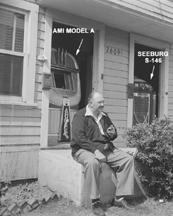
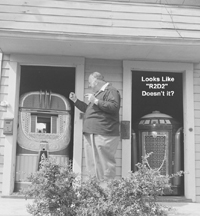
Harold E. Meier and His Jukebox Treasure House
That's an AMI Model A Mother of Plastic and a The Seeburg Models S-146 Trashcan
note that Harold is wearing argyle socks...
Click to Enlarge
In my research, I came across a set of photos that were made by Allan Grant, the famous Hollywood photographer who is best known as the fellow who shot the last session with Marilyn Monroe before her untimely death. In the early 1970s, Grant came across a forlorn old man named Harold E. Meier who was about to be evicted from a fairly drab house in the San Fernando valley. It seems that the house at No. 2609 1/2 was filled with jukeboxes -- and not just any jukeboxes, but the absolute cream of the crop. I think that we would all benefit by a look at Harold's collection. If you are reading this in 2050, you should definitely take a detailed look at Harold's collection.
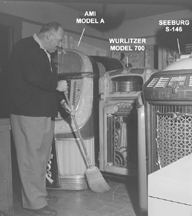
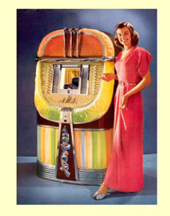
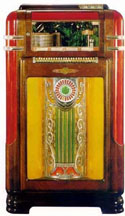
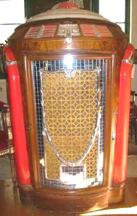
Harold E. Meier Sweeping Up in a Gallery of Exquisite Treasures
The AMI Model A Mother of Plastic in a more elegant light
The Wurlitzer Model 600 in full chromatic glory
The Seeburg Model 146 Trashcan showing the mirror mosaic on the front
Click to Enlarge
Photographer Grant followed Meier through his house, going from room to room. Meier stopped to do a bit of sweeping in front of three legendary machines. Since they are not shown at their best when crowded one atop the other, I have included photos of the three machines in all their glory. The black and white photo shows the deep molded plastic on the AMI Model A , but conceals the elaborate mirror mosaic on the Seeburg Trashcan.
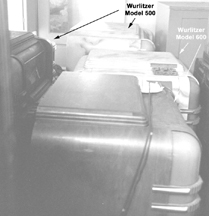
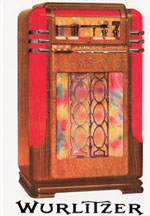
The Early Wurlitzer Salon
Compare the "Chevrons" on the pilasters
Click to Enlarge
here is a picture of some Wurlitzer jukeboxes arranged rather haphazrdly in a room. By counting "Chevrons", it looks like there are two Model 500s (3 Chevrons) and two Model 600s (2 chevrons.) Of note, the Model 600 has the coin slots on the top of the machine.
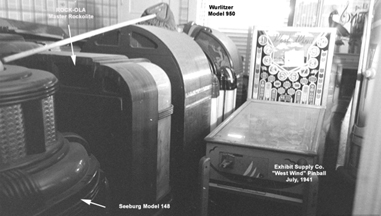
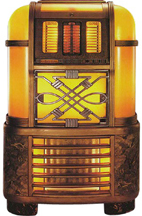
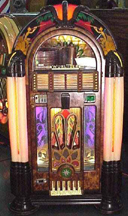
The Jukebox-Pinball Room
There are TWO (2) Wurlitzer Model 950 Jukeboxes here
The Rockola Master Rockolite aka the Luxury Light-up
Click to Enlarge
Another room offered yet another treasure trove. There are TWO (2!) Wurlitzer Model 950 Jukeboxes (known as "Pipes of Pan") that are quite hard to find. Many authors prefer the 950 to any of Paul Fuller's other designs for Wurlitzer. There is another Seeburg "Trashcan" and a Rock-Ola Master Rockolite.
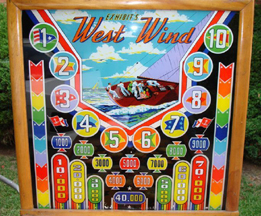
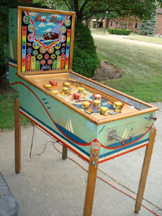
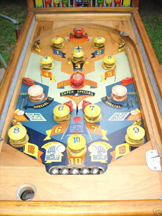
The West Wind Pinball Machine
Made by the Exhibit Supply Company
It does not have flippers
Click to Enlarge
Of note, a pinball machine also makes its appearance. It is the West Wind made by the Exhibit Supply Company, first issued in July of 1941. It is the only pinball machine ever made that has a Yacht Racing theme.
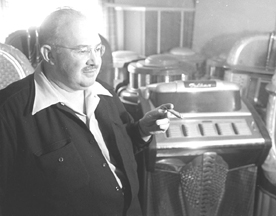
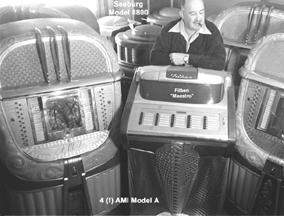
Harold E. Meier and the Filben
Yes, there are FOUR Ami Model A and Three Seeburg Model 8800 machines in one room
I can see that Harold is proud of the Filben
Click to Enlarge
The AMI Model A weighs about 800 pounds, and it would not be easy to heft them around from photo to photo. My guess is that he had at least six of them! Grant took the pictures shown above in a room that had FOUR (4!) of the Model As. In addition to that, there were also three Seeburg Model 8800s. That is certainly remarkable, but even amongst these treasures, the Filben Maestro stands out like a shining beacon.
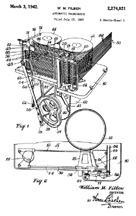
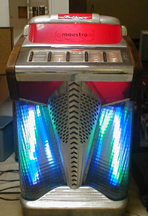
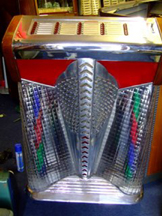
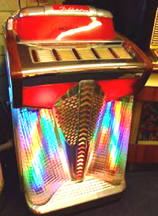
More on the Filben FP-300 Maestro
Filben Changer patent No. 2,274,921
Batavia Metal Products Company
Click to Enlarge
The Batavia Metal Products Company made less than 900 of these and was forced out of business in the mid 1940s because they could not get materials. One suspects that the other manufacturers colluded in this process. In all likelihood, the Filben is one of the rarest (if not the rarest) of all jukeboxes. William Filben invented a new 30 record changer mechanism and took it to David Rockola who agreed to manufacture and distribute the machine. They were to be made under the name "Filben" so as not to undermine the Rock-Ola brand while the new changer was being tested in the marketplace. The first prototype models were made in September 1938. Unfortunately Filben died, and his heirs decided to leave Rockola and form a new company called the Filben Manufacturing Co.; The Batavia Metal Products company actually produced the machines and they were distributed by the U.S. Challenge Co. of Chicago. [The first cabinets were briefly named Mirro-cle Music, an amalgamation of the two words mirror and miracle.] Production was halted because of the war. In 1947, Maestro was produced for a short period. Apparently, two versions were made, one with red plastics often referred to as the FP-300 and another, even rare one with green plastics was designated FE-300. (You can also see them listed as FP-305 and FE-305.)
David Rockola was not thrilled at the possible competition from the Filben, since his boxes only had 20 selections while the Filben had 30. Rockola was able to block production of the Filben after only 896 units had been produced, winning a patent infringement case in August of 1948. The Filben passed into history.
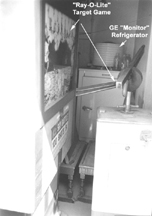
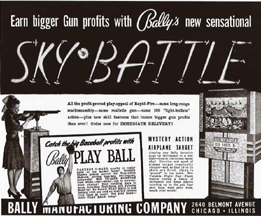
On the Back Porch
The Sky Battle Coin Operated Target game game...
Originally made by the Midway Co. which was, in turn acquired by Bally
Click to Enlarge
As we leave Harold's modest dwelling, a glance at the back porch reveals a "Sky Battle" target game. Although the ad shoows a hot looking number in a short skirt behind the gun, one can just imagine a kid in the 1940s crouched behind the machine gun taking his "100 Shots for a Nickel" imagining that he is locked in combat with Messerschmitts and Zeroes. This game most likely uses the same principles as the Seeburg "Ray-O-Lite" arcade shoooting gallery that was sold in the mid 1930s. The gun emits a focused beam of light and the targets have photocells. Intense light striking the cells would activate a switch to record a "hit". These machines always suffered from problems with ambient light. A flash bulb could destroy the entire Luftwaffe.
As an afterthought, we also see a GE Monitor Top refrigerator, something that has also, of late, become collectible. You can read all about this pioneering device on our Trip to a 1930s Appliance Show page.
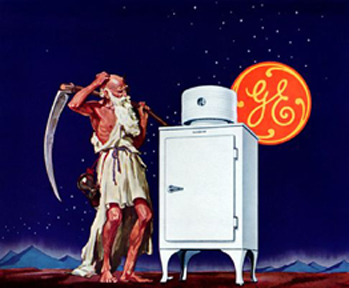
Advertisement Suggesting that the Monitor-Top Would Last Longer Than Time
Click Photo to Enlarge
At this point, I'd like to pay tribute to Harold E. Meier, wherever he may be. He had superb taste. I wish that I could have met him. I hope that by menioning his name, I have kept his memory alive. I hope that he is in Heaven, well supplied with argyle socks and Maduro cigars, listening to Stan Kenton on his Filben. If anyone out there knows more about Harold Meier and the magical house at #2609 1/2, please Contact me.
And, thanks to the magic of the internet, we have this from Jim, one of our readers:
"... [Harold] has the look of a coin machine operator to me and sure enough in the Sept. 14, 1946 Billboard Magazine on page 124 he is identified as an operator in Los Angeles. He is also identified as an operator in LA in the Oct 15, 1949 Billboard on page 108. ... I bought my first Jukebox in 1953, a 1937 model Wurlitzer model 616, from a dealer in NJ for $35 and had it shipped to Roanoke, VA. After I moved to Maryland my father got rid of it. Years later I bought another Wurlitzer, a 1965 model, that I gave to my daughter. I also owned a number of pinball machines when I was a teenager and years later bought a used Gottlieb "Rocket Ship" that I gave to my daughter ..."
Jim's observations are borne out by this article that we found in Billboard Magazine:

Article Mentioning Harold Meier
October 15, 1949 issue of Billboard Magazine
Click Photo to Enlarge
In May, 2011 we heard from Linda, a relative of Harold's. She writes:
"... Hi, Harold Meier was my grandfather's older brother. He lived in Los Angeles on Adams Street with his wife Audry. Harold and Audry had two children Hal and a sister (I don't remember her name). Harold and his wife owned and lived in a large commercial /residential building. There was an appliance store downstairs he started collecting Juke boxes at that time. After the Watts Riots they moved out to the Valley. Enjoyed seeing photos of Uncle Harold, haven't seen him since I was very young ..."
Hopefully, others can fill in more of the missing information on Harold Meier so that we can pay a fitting tribute to him
In the 1960s, partner dancing went away and the jukebox moved from the central focus to background music. Big chains like McDonalds had no jukeboxes, preferring that their customers order, eat and leave. In fact, the venues where juke boxes held sway began to slowly disappear -- drug stores no longer had soda fountains. Fast food places killed the malt shop and the drive-in. Diner owners began to turn their chrome and steel facilities into "Family Restaurants" -- and the juke box was the first casualty. Since nobody danced, the charming roadhouse with a Wurlitzer, so often portrayed by Albert Dorne vanished as real estate was transformed into tract homes and shopping centers. It was not until the great nostalgia wave of the 1980s that retro diners began to reappear with a scrubbed up look back at the 1940s and 1950s -- invariably, these establishments included a replica of a Wurlitzer 1015. Today, the retro diner is largely the province of people with small children, a theater-set for a version of a 1950s that never existed. (Back then, the waitstaff were English speaking citizens, there was never a "low carbohydrate" or "heart-healthy" option for food, and everybody smoked.)
The "Golden Age" of jukeboxes is long gone, and the remnants of nearly 3,000,000 boxes made between 1935 and 1955 are either in museums or in the basements of guys who drive Corvettes and raise Dobermans... or the basements of the ex-wives of guys who drive... From what I can tell by snooping around the internet, there are plenty of Golden Age jukeboxes for sale for those with $6,000 to $16,000. For those who have already made the investment, there are also a large number of persons who will sell you manuals, parts and services at prices consistent with a $6,000 to $16,000 initial investment. After playing "Hound Dog" or "In the Mood" a few times, my guess is that the thing will become a very expensive dust catcher, eagerly awaiting yet another collector with a bleached blonde wife, a Corvette, a Doberman and, of course, $6,000 to $16,000.
FREE MANUAL!
for the Wurlitzer Model 1100!
Here is the Table of Contents:
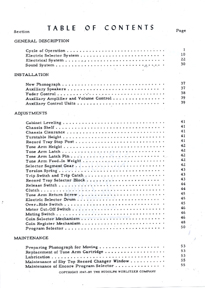
Click to Enlarge
The Service Manual:
- What's New About the Model 1100?
- Cycle of Operation
- Electrical Selector
- Electrical System
- Sound System
- Installation
- Adjustments
- Maintenance
- Oversized Schematics (pp 25,33,34,35)
The Parts Catalogue:
- Illustrated Parts Catalogue, Part 1
- Illustrated Parts Catalogue, Part 2
- Illustrated Parts Catalogue, Part 3
- Illustrated Parts Catalogue, Part 4
- Numerical Parts Catalogue
There are a lot of jukebox websites on the ineternet. Most of them are, in one way or another, associated with people who want to sell you something. Some of them are written with excruciatingly fine details about the industry. You should consult them if I have stimulated your appetite about this subject. You'll note that a lot of current jukebox interest is outside the USA -- this is a testament to the enduring legacy of American culture during the period 1930-1950. If you are reading this in 2050, most of these links will be dead.
- Pinball Rebel Probably the best collection of pictures on the net
- Raphael Lankars Site A good listing of jukeboxes by year
- Jukebox World, Germany A comprehensive look at jukeboxes, compiled with Teutonic precision
- Jukebox Revival A Dutch site that sells everything from manuals to capacitors
- Tom's Jukebox resource Center EXTREME Detail about the Jukebox Industry
- Rowe-AMI Corporate Webpage
- Rock-Ola Corporate Webpage
- Wurlitzer-Gibson Corporate Site
- Tom's Gigantic Links Page hundreds of links!
- The Australian Jukebox Industry
Counter for THIS Web Page
Home | About Lindy | 1940s Collectibles | Upcoming Events | Vintage Clothing
The Guide - Establishments - Travel - Accessories
Music | Links | Photo Gallery | Extras | Contact